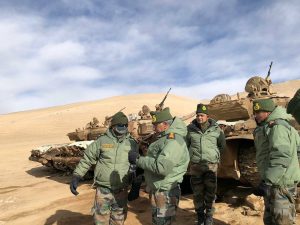Sudha Ramachandran

On August 30, over 100 People’s Liberation Army (PLA) soldiers reportedly crossed the Line of Actual Control (LAC) at Barahoti in Uttarakhand, according to a recent report in Economic Times. The Chinese soldiers entered some 5 km into territory on the Indian side of the LAC. Although they remained here for 3 hours and damaged infrastructure, including a bridge, Indian troops did not challenge them or force them to leave.
The Indian government has not issued an official statement on the incident yet.
Such a major incursion should have prompted a response from Indian troops on the ground or at least prompted a statement from government officials. It did not.
But the official silence is not surprising. With regard to border tensions with China over the past year, denial and silence has been an important component of the Narendra Modi government’s strategy. This is quite unlike its aggression, often excessive, when it comes to Pakistan undermining India’s national security.
In April last year, China began a build-up of its troops in the western sector of the LAC in eastern Ladakh and followed that up with incursions several kilometers into the Indian side of the de facto border at several points. Although reports in the media were drawing attention in May to the rising presence of Chinese soldiers, heavy weaponry, and tents on the Indian side of the LAC, the Indian government dismissed the reports. Indian Army chief General Manoj Naravane described the growing crisis as “temporary and short duration face-offs.”
Indeed, even after a bloody face-off at the Galwan Valley on June 15 resulted in the death of 20 Indian soldiers and an undisclosed number of Chinese soldiers, Prime Minister Narendra Modi told an all-party meeting that the Chinese had neither “intruded into our border, nor has any post been taken over by them.”
In his attempt to score points over the opposition and portray himself as being on top of the situation at the border, he was endorsing China’s occupation of Indian land, weakening India’s position at talks.
“Today, we possess the capability that no one can eye even one inch of our land. India’s armed forces have the capability to move into multiple sectors at one go,” he thundered at the all-party meeting.
But the reality on the ground is different as India is ceding territory to the Chinese along the border.
Twelve rounds of talks between Indian and Chinese military commanders have taken place so far. While they have led to disengagement of troops at a few friction points, the process is going against India’s interests. The two sides are establishing no-patrolling buffer zones but these are coming up in territory that has been under Indian control. At Galwan, for instance, the LAC has shifted a kilometer in China’s favor.
India has not played its cards well at the negotiations, either. It handed over the heights of the Kailash Range at Pangong Tso – it captured the strategic heights here from the PLA in August – to get the Chinese to disengage from the north bank of Pangong Tso. By returning Kailash Heights, India surrendered its “sole bargaining chip” early in the negotiations. It could have leveraged this instead to get the Chinese to clear out of Depsang Plains, which is vital to India’s national security.
While the two sides have disengaged from the south bank of Pangong Tso and Gogra and have set up buffer zones in Galwan Valley and Pangong Tso’s north bank, they are yet to begin talks on Hot Springs, Demchok, and Depsang. Meanwhile, with the incident at Barahoti in August, yet another friction point looms, this time in the LAC’s middle sector.
While incidents of Chinese “transgressions” in the middle sector are not new – at the height of the crisis in Doklam in 2017, for instance, PLA soldiers breached the LAC at Barahoti – “there is an increase in the number of PLA troops coming in” here of late, defense ministry officials told The Hindu. During the recent incident at Barahoti, not only did PLA soldiers come in from “multiple locations within the Barahoti bowl,” but also this time around, the transgression was “on a much higher scale,” the officials said.
The PLA could be putting pressure on India in the other sectors to win concessions in the western sector in the ongoing military talks. It could also be testing India’s military preparedness in other sectors and its resolve to push back Chinese soldiers entering the Indian side. Its probing missions in other sectors could be aimed at extending its aggression further across the LAC.
India has sent out a signal of weakness by not challenging the PLA intrusion at Barahoti. Did Modi government raise the matter through diplomatic channels? Or does it propose to object to such transgressions in the 13th round of talks, which are expected to take place early this month?
Delhi’s stony silence on the incident so far does not bode well. In his preoccupation with projecting a tough image to voters at home, Modi may prefer to simply ignore the incident or deny it happened.
No comments:
Post a Comment